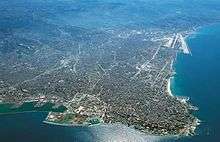Culture of Lebanon
The culture of Lebanon and the Lebanese people emerged from various civilizations over thousands of years. It was home to the Phoenicians and was subsequently conquered and occupied by the Assyrians, the Greeks, the Romans, the Persians, the Arabs, the Crusaders, the Ottoman Turks and the French. This variety is reflected in Lebanon's diverse population, composed of different religious groups, and features in the country's festivals, musical styles, literature, cuisine of Lebanon and architecture of Lebanon. Tourism in Lebanon is popular with periods of interruption during conflict.
| Part of a series on the |
| Culture of Lebanon |
|---|
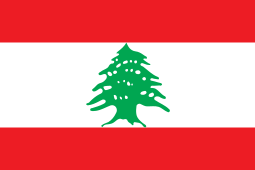 |
| History |
| People |
| Languages |
| Cuisine |
| Religion |
| Art |
| Literature |
|
Music and performing arts |
|
Media |
| Sport |
|
Monuments
|
|
Symbols |
|
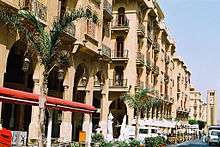
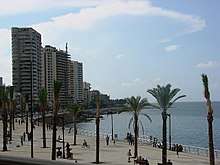
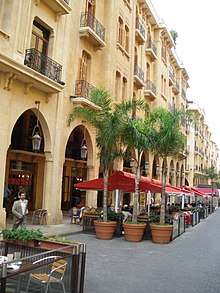
Despite the religious and denominational diversity of the Lebanese, they “share an almost common culture”.[1] Based on Article 11 of the Constitution of Lebanon states: "Arabic is the official national language. A law determines the cases in which the French language is to be used." The spoken Lebanese is the language used in public which is a hybrid of the languages of the above-mentioned cultures, Food, music, and literature are deep-rooted “in wider Mediterranean and Levantine norms”.[1]
The hilly Mediterranean Geography of Lebanon has played a role in shaping the history of Lebanon and its culture. Archaeology of Lebanon is conducted to explore the area's past.
Arts
By the turn of the 20th century, Beirut was vying with Cairo to be the major center for modern Arab thought, with many newspapers, magazines and literary societies. Additionally, Beirut became a thriving epicenter of Armenian culture with varied productions[2] that was exported to the Armenian diaspora.
Visual arts
Daoud Corm (1852-1930), Habib Serour (1860-1938) and Khalil Saleeby (1870-1928) are considered the first successful professional studio artists in Lebanon, with careers extending to Europe. All were trained outside Lebanon, with Corm and Serour attending Roman academies and Saleeby British and American ones. They were known for portraiture of Lebanese high society and men of religion, as well as Christian sacred art in the case of Corm and Serour. [3][4]
Mustafa Farroukh (1901-1957) was one of Lebanon's most prominent painters between the 1920s and the 1950s. Formally trained in Rome and Paris, he exhibited in venues from Paris to New York to Beirut over his career.[5]
Farid Mansour (1929-2010) was a Lebanese multi-talented painter and sculptor . Being trained in Italy and England, Mansour mastered several painting and sculpting techniques. His works were exhibited in London, Paris, New York as well as Lebanon and Syria.
Contemporary art
Contemporary art started in Beirut immediately after the end of the civil war (1975-1991).
Many contemporary artists are currently active, such as Walid Raad, a contemporary media artist currently residing in New York.[6]
Two contemporary art exhibition centers, the Beirut Art Center and the Beirut Exhibition Center (does not exist anymore) in the BIEL area reflect the vibrant Lebanese contemporary art scene. These two centers are intended to host exhibitions and are a must in the world of international as well as local contemporary art. Many art galleries also add to the local art scene, exhibiting the works of artists such as Ayman Baalbaki,[7] Akram Zaatari,[8] Marwan Sahmarani,[9] Nadim Asfar,[10] Lamia Joreige,[11] Jean Marc Nahas,[12][13] Ricardo Mbarkho,[14] Mansour El-Habre,[15] Anita Toutikian and many others. These galleries are run by gallerists such as Saleh Barakat[16] (Agial), Galerie Mark Hachem,[17] Fadi Mogabgab,[18] Nadine Begdache (Galerie Janine Rubeiz),[19] Odile Mazloum (Galerie Alwane).[20]
Located in Foch Street in the Solidere area, FFA Private Bank is home to many temporary exhibitions of contemporary local artists as well as to a permanent display of paintings by Lebanese artists (Sahmarani, Baalbaki, Hanibal Srouji ... ) or foreign artists such as Fabienne Arietti's "Nasdaq".[21] A Jean Dubuffet's huge sculpture can also be seen when visiting the atrium of Bank Audi Plaza, located in a beautiful contemporary building designed by Kevin Dash. By Strolling through the streets of the city one can find some interesting works such as sculptures of Michel Basbous in the Bank of Lebanon street.
Ashkal Alwan, the Lebanese association for plastic arts and a platform for the creation and exchange of artistic practices. It was founded by Christine Tohmé, Marwan Rechmaoui, Rania Tabbara, Mustapha Yamout and Leila Mroueh. Initially, Ashkal Alwan promoted and introduced the work of artists who have been engaged in critical art practices within the context of post-war Lebanon. The Home Works Forum is a multidisciplinary platform that takes place in Beirut, Lebanon about every other year. it has evolved into one of the most vibrant platforms for research and exchange on cultural practices in the region and beyond.
Umam Documentation & Research runs an exhibition space (The Hangar) located at Haret Hreik, in Beirut's Southern suburb with extensive events.
In the field of digital art, the artist Ricardo Mbarkho investigates the transformation of cultural industries into creative industries.
In the field of photography, the Arab Image Foundation has a collection of +4000 photographs from Lebanon and the Middle East. The photographs can be viewed in a research center and various events and publications have been produced in Lebanon and worldwide to promote the foundation.
Architecture
.jpg)
Architecture in Lebanon includes the legacies of various occupying powers including the Romans, Phoenicians, Ottomans and French, as well as post independence developments.
When the Ottomans exiled Fakhreddine to Tuscany, Italy in 1613, he entered an alliance with the Medicis. Upon his return to Lebanon in 1618, he began modernizing Lebanon. He developed a silk industry, upgraded olive-oil production, and brought with him numerous Italian engineers who began the construction of mansions and civil building throughout the country.[22] The cities of Beirut and Sidon were especially built in the Italianate style.[23]
The Italianate, specifically, Tuscan, influence on architecture in Lebanon dates back to the Renaissance when Fakhreddine, the first Lebanese ruler who truly unified Mount Lebanon with its Mediterranean coast executed an ambitious plan to develop his country.
The influence of these buildings, such as the ones in Deir el Qamar, influenced building in Lebanon for many centuries and continues to the present time. For example, streets like Rue Gouraud continues to have numerous, historic houses with Italianate influence.[24] Buildings like the Nicolas Sursock mansion on Rue Sursock, which is today a major museum, attest to the continuous influence of Italianate architecture in Lebanon.
Literature
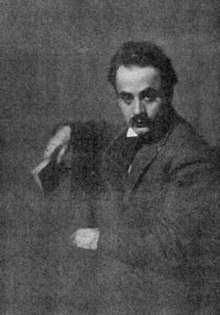
Khalil Gibran (1883–1931), who was born in Bsharri, is particularly known for his book The Prophet (1923), which has been translated into more than twenty different languages.[25] Several contemporary Lebanese writers have also achieved international success; including Elias Khoury, Amin Maalouf, Hanan al-Shaykh, and Georges Schehadé.
Several contemporary Lebanese writers have also achieved international success; including Elias Khoury, Amin Maalouf, Hanan al-Shaykh, and Georges Schehadé. Raméz A. Baassiri, a contemporary writer of Lebanese origin, authored a book on Entrepreneurship titled "Interrupted Entrepreneurship: Embracing Change in the Family Business" on family business cycles. The book published with ForbesBooks, was voted the 88th best book of all time by Book Authority.[26][27][28][29][30]
Poetry
Popular culture
Music
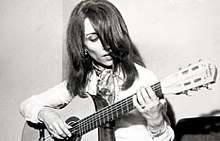
Music is pervasive in Lebanese society.[31] While traditional folk music remains popular in Lebanon, modern music reconciling Western and traditional Arabic styles, pop, and fusion are rapidly advancing in popularity.[32] Radio stations feature a variety of music, including traditional Lebanese, classical Arabic, Armenian[33] and modern French, English, American, and Latin tunes.[34] Prominent traditional musicians include Fairuz, an icon during the civil war, Sabah Melhem Barakat, Wadih El Safi, Majida El Roumi, and Najwa Karam who built an international audience for the genre.[31] Historical figure and Lebanese musical pioneer Lydia Canaan is listed in the catalog of the Rock and Roll Hall of Fame and Museum's Library and Archives in Cleveland, Ohio, USA[35][36] as the first rock star of the Middle East.[36][37][38][39][40] Canaan's unique style fuses Middle-Eastern quarter notes and microtones with anglophone rock. Marcel Khalife, a musician who blends classical Arab music with modern sounds, boasts immense[41] popularity for his politically charged lyrics.[31][32] Distinguished pop artists include Nancy Ajram, Haifa Wehbe, Fadl Shaker, Elissa, and Mika.[31]
According to the World Intellectual Property Organization, Lebanon's music industry is growing and could attain leading status in the region.[42] Lebanese performers are celebrated throughout the Arab World,[43] and with the notable exception of Egypt enjoy increasing regional popularity.[42] Rising demand for Arabic music outside Western Asia has provided Lebanese artists with a small but significant global audience. However, widespread piracy continues to inhibit the music industry's growth.[42]
Media
Lebanon is not only a regional center of media production but also the most liberal and free in the Arab world.[44] According to Press freedom's Reporters Without Borders, "the media have more freedom in Lebanon than in any other Arab country".[45] Despite its small population and geographic size, Lebanon plays an influential role in the production of information in the Arab world and is "at the core of a regional media network with global implications".[46]
After independence, Beirut emerged as the epicenter of publishing in the Arab world, characterized by free and liberal media and literary scenes.[47] Lebanon's press became a huge industry despite the country's small size and has remained a haven for Arabic publishing.[48] The establishment of modern printing presses and sophisticated book distribution channels made Beirut a regional publishing leader, and gave the Lebanese publishers a dominant role in Arab publishing.[49] Lebanon hosts annually two important regional publishing events, the Beirut Book Fair and the Beirut Francophone Book Fair.[50]
Television in Lebanon was introduced in 1959, with the launch of two privately owned stations, CLT and Télé Orient that merged in 1967 into Télé Liban.[51] Lebanon has ten national television channels, with most being affiliated or supported by certain political parties or alliances.
Lebanon was one of the first countries in the Arabic-speaking world to introduce internet. Lebanese Photographers like Said Mhamad have become popular all across world because of Internet and social media.[52][53] Beirut's newspapers were the first in the region to provide readers with web versions of their newspapers. By 1986, three newspapers from Lebanon were online, Al Anwar, Annahar, and Assafir, and by 2000, more than 200 websites provided news out of Lebanon.[46]
Cinema
Cinema of Lebanon, according to film critic and historian, Roy Armes, was the only other cinema in the Arabic-speaking region, beside Egypt's, that could amount to a national cinema.[54] Cinema in Lebanon has been in existence since the 1920s, and the country has produced over 500 films,[55] some of which are:
- West Beirut – by Ziad Doueiri, released in 1998, received the Prix François Chalais at the Directors' fortnight of the Cannes Film Festival (1998)
- Mabrouk Again – by Hany Tamba, released in 2000
- The Kite– by Randa Chahal, released in 2003, received many prestigious awards including the Silver Lion, Prix de la paix- Gillo Pontecorvo and Prix de la Lanterne Magique at the Venice Film Festival (2003)
- After Shave – by Hany Tamba, released in 2005, received the 2006 French César Award for best foreign short film
- Bosta – by Philippe Aractingi, released in 2005
- Under the Bombs – by Philippe Aractingi, released in 2006
- Caramel – starring and directed by Nadine Labaki, released in 2007
- Where Do We Go Now? – starring and directed by Nadine Labaki, released in 2011, received the Cadillac People's Choice Award at the Toronto International Film Festival (2011)
- Capernaum – written by Nadine Labaki, Jihad Hojaily and Michelle Keserwany, released in 2018, the film was selected as the Lebanese entry for Best Foreign Language Film at the 91st Academy Awards.
Theatre
Lebanese theatre has its origin in passion plays. The musical plays of Maroun Naccache from the mid-1800s are considered the birth of modern Arab theatre.[56] Some scholars like Abdulatif Shararah divided theatre in Lebanon into three phases: translations of European plays, Arab nationalism, and realism.[57]
Cultural relations between Lebanon and Egypt
The cultural relations between Lebanon and Egypt is considered a unique kind of cultural historical relations, Because there is a considerable overlap between the Lebanese and Egyptian cultures, especially in the fields of literature, theater, cinema and journalism, all of them played an integral role towards each other especially in theater, cinema and journalism, that's what was confirmed by the Conference Egypt in the eyes of the Lebanese and which is Within the activities of the cultural program Egypt in the eyes of the World . Which is held at the headquarters of the Egyptian Ministry of Tourism, and in the presence of the Lebanese Ambassador in Egypt, Madeleine Tabar and Ahmed Ghanem founder of cultural program Egypt in the eyes of the World and an elite of Lebanese artists.[58]
Fashion
Many Christians and most Muslims who live in the cities wear modern stylish clothes. In the countryside, women sometimes wear traditional colorful skirts and men wear a traditional sherwal (baggy trousers). Dress was historically Ottoman, but remains only as part of the folk culture. Today, almost all Lebanese wear modern clothing.
Famous names in the Lebanese fashion industry include Elie Saab, Zuhair Murad, Darin Hachem, Reem Acra, and Rabih Kayrouz
Holidays and festivals
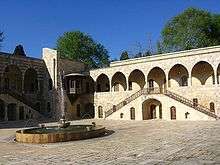
Lebanon celebrates national holidays and both Christian and Muslim holidays.
Christian holidays are celebrated following both the Gregorian Calendar and Julian Calendar. Maronites, Greek Orthodox, Catholics, Protestant, and Melkite Christians follow the Gregorian Calendar and thus celebrate Christmas on 25 December. Armenian Orthodox Christians celebrate Christmas on 6 January, as they follow the Julian Calendar.
Muslim holidays are followed based on the Islamic lunar calendar. Muslim holidays that are celebrated include Eid al-Fitr (the three-day feast at the end of the Ramadan month), Eid al-Adha (The Feast of the Sacrifice) which is celebrated during the annual pilgrimage to Mecca and also celebrates Abraham’s willingness to sacrifice his son to God, the Birth of the Prophet Muhammad, and Ashura. Lebanon's National Holidays include Workers Day, Independence day, and Martyrs Day.
Music festivals, often hosted at historical sites, are a customary element of Lebanese culture.[59] Among the most famous are Baalbeck International Festival, Byblos International Festival, Beiteddine International Festival, Broumana Festival, Batroun Festival, Dhour Chwer Festival and Tyr Festival.[59][60] These festivals are promoted by Lebanon's Ministry of Tourism, Lebanon Hosts about 15 Concerts from International Performers Each Year Ranking Number one for Nightlife in the Middle east and 6th Worldwide.[61]
Cuisine

Lebanese cuisine is similar to those of many countries in the Eastern Mediterranean, such as Syria, Turkey, Greece, and Cyprus.
The Lebanese national dishes are the kibbe, a meat pie made from finely minced lamb and burghul (cracked wheat), and the tabbouleh, a salad made from parsley, tomatoes, and burghul. The national beverage is arak, a strong anise-flavored liquor made from fermented grape juice. It is usually drunk with water and ice, which turns the clear liquid milky-white, and usually accompanies food. Arak is a strong spirit similar to the Greek ouzo and the Turkish raki.
Lebanese restaurant meals begin with a wide array of mezze - small savoury dishes, such as dips, salads, and pastries. The mezze are typically followed by a selection of grilled meat or fish. In general, meals are finished with Arabic coffee and fresh fruit, though sometimes a selection of traditional sweets will be offered as well.
M'Juhdara, a thick stew of onions, rice, and lentils, is sometimes considered poor man's fare and is often eaten around Lent by people in the Lebanese diaspora.
Beirut and its environs contain many restaurants of various national origins. At the same time, wine is growing in popularity and a number of vineyards currently exist in the Bekaa valley and elsewhere. Beer is also highly popular and Lebanon produces a number of local beers, of which almaza is perhaps the most popular.
Food in daily life
Lebanese cuisine is influenced by other Mediterranean cuisines. Pita bread is a staple. The Lebanese enjoy hummus (a chick pea dip), fool (a fava bean dip), and other bean dishes. Rice is nearly a staple and pasta is popular. Salted yogurt is common in many dishes. Red meat and chicken are common but are usually eaten as part of a dish. Eating in Lebanon is tied to family: people almost never eat alone. The Lebanese consider eating out a social and almost aesthetic experience. During Lent, Christians eat meatless dishes and at Saint Barbara, they eat a variety of wheat-based dishes. Lebanon sells fruits and vegetables to neighboring Arab countries, as well as to Italy, France, and the United States. Wine is produced in the Bekaa and exported to Europe.
Society
Lebanese society is similar to certain cultures of the Mediterranean as the country is uniquely diverse religiously .[62] It is often considered as Europe's gateway to Western Asia as well as Asia's gateway to the Western World.[63]
Mixed-sex groups of youth are very common especially in Verdun, Hamra Street, Ashrafieh, and downtown Beirut as well as other places. Premarital physical sexual relations are very common, although intercourse is frowned upon and avoided by both Muslim and Christian girls.
The contraceptive prevalence rate is estimated at 58%, of which 34% modern contraceptives, primarily IUDs, pills and condoms.[64] Prostitution in Lebanon is nominally legal.[65]
By comparison to most other Arab capitals, Beirut is more modern and more culturally liberal. Compared to Damascus, Cairo, and Baghdad, and especially in contrast to such cities as Riyadh, Beirut is more tolerant with regard to relations between men and women, and also with regard to homosexuality.
Notwithstanding the persistence of traditional attitudes regarding the role of women, Lebanese women enjoy equal civil rights and attend institutions of higher education in large numbers (for example, women constituted 41 percent of the student body at the American University of Beirut in 1983). Although women in Lebanon have their own organizations, most exist as subordinate branches of the political parties.
While gay sex does not enjoy wide acceptance, Beirut has a number of gay bars and nightclubs, in addition to five LGBT rights organizations, namely Helem, Arab Foundation for Equality (AFE), Nasawiya-Feminist Collecrive, Proud Lebanon, and Mosaïque.
Sports
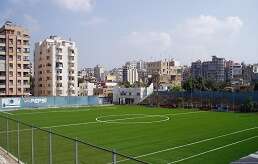
- Football is the most popular sport in Lebanon. In association football, the governing body for Lebanon is the Federation Libanaise de Football (FLDF). The FLDF organises the men's, women's, and futsal national teams.
- Basketball - Basketball is one of the most popular sports in Lebanon. In basketball, the governing body is the Lebanese Basketball Federation, and it is a member of FIBA Asia. The Lebanon national basketball team has qualified three consecutives times to the FIBA World Championship in 2002, 2006, and 2010, and the team is ranked 24th in the world and the women's national team is ranked 61st in the world. The most successful Lebanese basketball clubs are Sporting Al Riyadi Beirut and Hekmeh-Sagesse, known as C.S. Sagesse or Sagesse for men and Antranik SC for women.
- Rugby league - Rugby league is a popular sport in Lebanon. The Lebanon national rugby league team qualified and played in the 2000 Rugby League World Cup and 2017 Rugby League World Cup. In the latter, they surprisingly beat France in their pool match, qualifying for the knockout stages and securing automatic qualification for the 2021 Rugby League World Cup.
- Weightlifting - Weightlifting has been, besides basketball, one of the biggest success stories in Lebanese sport. In the 1972 Summer Olympics, Mohamed Traboulsi won the silver medal, in addition to many gold medals in continental and regional championships and is considered one of the most revered athletes in Lebanon.
- Winter sports - Skiing and snowboarding are popular sports up in the mountains, and the country boosts six ski resorts, with slopes suitable for skiers and snowboarders of all ages and levels of experience. Off-slope, there are many opportunities for cross-country skiing, snowshoeing, and snowmobiling.
- In the summer, skilifts can be used to access some of Lebanon's best hiking trails, with panoramic views stretching as far as Cyprus to the west and Syria to the east on clear days. Canoeing, cycling, rafting, climbing, swimming, sailing, and spelunking are among the other common leisure sports in Lebanon. Adventure and extreme sports are also possible throughout the country.
- Running - The Beirut International Marathon is held every fall, drawing top runners from Lebanon and abroad. Shorter races are also held for youth and less serious competitors. Race day is promoted as a fun, family event, and it has become a tradition for many to participate in costumes or outlandish clothing.
- Equestrian sports - Equestrian sports are increasing in popularity, especially in the highlands of Lebanon, where the game of polo is played in farming villages and towns around the country.
- Rugby union - Rugby union is increasing in popularity, and was introduced from France. The Lebanon national rugby union team represents Lebanon in international rugby union, and is governed by the Lebanon Rugby Union.
In 2009, the country hosted the Winter Asian Games, which took place in the capital, Beirut.
- Other sports - Sports such as surfing, bodyboarding, netball, cycling, beach soccer, skateboarding, baseball, American football, and sporting events such as triathlons are increasing in popularity.
References
- Stokes, Jamie. Encyclopedia of the Peoples of Africa and the Middle East, page 406
- Migliorino, p. 166
- "Khalil Saleeby (1870-1928): A Founder of Modern Art in Lebanon". www.aub.edu.lb. Retrieved 2019-10-02.
- "One Fine Art | artists - painters / habib srour". www.onefineart.com. Retrieved 2019-10-02.
- "Moustafa Farroukh". Kaftoun.com. 2 July 2010. Archived from the original on 7 March 2012. Retrieved 5 May 2012.
- "Media Art Net | Ra'ad, Walid: Biography". Medienkunstnetz.de. Archived from the original on 30 April 2012. Retrieved 5 May 2012.
- "Ayman Baalbaki". lucegallery. Archived from the original on 26 April 2010. Retrieved 5 May 2012.
- "Earth of Endless SecretsWriting for a Posterior TimeAkram Zaatari". Beirut Art Center. 22 July 2009. Archived from the original on 24 October 2011. Retrieved 5 May 2012.
- "Marwan Sahmarani Biography and Links – Marwan Sahmarani on artnet". Artnet.com. Archived from the original on 13 January 2012. Retrieved 5 May 2011.
- "Nadim Asfar". Galerie Tanit. 10 May 2008. Archived from the original on 28 April 2012. Retrieved 5 May 2012.
- "Independent Curators International – Lamia Joreige". Curatorsintl.org. Archived from the original on 17 December 2011. Retrieved 5 May 2012.
- "Jean-Marc Nahas". Jean-Marc Nahas. Archived from the original on 18 January 2012. Retrieved 5 May 2012.
- "Jean-Marc Nahas". Art of the Mid East. Archived from the original on 9 April 2012. Retrieved 5 May 2012.
- "Ricardo Mbarkho". www.ricardombarkho.com. Archived from the original on 28 October 2017. Retrieved 8 May 2018.
- "Mansour el Habre". ArtMed Gallery. Archived from the original on 7 March 2012. Retrieved 5 May 2012.
- "Yale World Fellows Program | The World Fellows". Yale.edu. Archived from the original on 24 August 2012. Retrieved 5 May 2012.
- "Mark Hachem Gallery :: Beirut.com :: Beirut City Guide". Beirut.com. Archived from the original on 24 January 2012. Retrieved 5 May 2012.
- "Art – Creativity's capital". Executive-magazine.com. Archived from the original on 26 January 2012. Retrieved 5 May 2012.
- "galerie JANINE RUBEIZ". galerie JANINE RUBEIZ. Archived from the original on 5 February 2012. Retrieved 5 May 2012.
- "Galerie Alwane". SAIFI VILLAGE. Archived from the original on 4 March 2016. Retrieved 1 August 2015.
- "Media Relations". FBI Private Bank. 7 December 2011. Archived from the original on 8 July 2010. Retrieved 5 May 2012.
- Carter, Terry; Dunston, Lara; Humphreys, Andrew (2004). Syria & Lebanon — Google Books. books.google.com. ISBN 978-1-86450-333-3. Retrieved 2010-01-18.
- Dib, Kamal; Dīb, Kamāl (2004). Warlords and merchants: the Lebanese ... - Google Books. Books.google.com. ISBN 978-0-86372-297-4. Retrieved 2010-01-18.
- "Premium content". Economist.com. 2008-09-11. Archived from the original on 2009-03-08. Retrieved 2010-01-18.
- The Hindu (5 January 2003). Called by life. The Hindu. 5 January 2003. Retrieved 8 January 2007.
- https://www.ypo.org/2018/11/seeing-the-opportunities-in-disruptive-interruptions/
- https://finance.yahoo.com/news/family-business-expert-shares-secrets-173000045.html
- "Family Business Expert Shares Secrets to Multi-Generational Success". forbes.com.
- "Our Authors | Raméz A. Baassiri". ForbesBooks.
- Baassiri, R.A. (2018). Interrupted Entrepreneurship(tm): Embracing Change in the Family Business. Forbes Books. ISBN 9781946633361.
- Carter, Terry; Dunston Lara (15 July 2008). "Arts". Lonely Planet Syria & Lebanon. Lonely Planet. Thomas Amelia (3 ed.). Lonely Planet. pp. 254–255. ISBN 978-1-74104-609-0. Retrieved 19 September 2009.
- Sheehan, Sean; Latif Zawiah (30 August 2007). "Arts". Lebanon. Cultures of the World (2 ed.). Marshall Cavendish Children's Books. p. 105. ISBN 978-0-7614-2081-1. Retrieved 19 September 2009.
- McKenzie, Robert. Comparing Media from Around the World, Pearson/Allyn and Bacon, 2006, p. 372 ISBN 0-205-40242-9
- Kamalipour, Yahya; Rampal Kuldip (15 November 2001). "Between Globalization and Localization". Media, sex, violence, and drugs in the global village. Rowman & Littlefield Publishers, Inc. p. 265. ISBN 978-0-7425-0061-7. Retrieved 19 September 2009.
- "Library and Archives Subject File (Rock and Roll Hall of Fame and Museum Records--Curatorial Affairs Division Records) - Rock and Roll Hall of Fame and Museum - Library and Archives - Catalog". catalog.rockhall.com. Retrieved 8 May 2018.
- O'Connor, Tom. "Lydia Canaan One Step Closer to Rock n' Roll Hall of Fame" Archived 2016-04-29 at the Wayback Machine, The Daily Star, Beirut, April 27, 2016.
- Salhani, Justin. "Lydia Canaan: The Mideast’s First Rock Star" Archived 2015-05-05 at the Wayback Machine, The Daily Star, Beirut, November 17, 2014.
- Livingstone, David. "A Beautiful Life; Or, How a Local Girl Ended Up With a Recording Contract in the UK and Who Has Ambitions in the U.S." Archived 2016-04-23 at the Wayback Machine, Campus, No. 8, p. 2, Beirut, February 1997.
- Ajouz, Wafik. "From Broumana to the Top Ten: Lydia Canaan, Lebanon's 'Angel' on the Road to Stardom" Archived 2015-06-19 at the Wayback Machine, Cedar Wings, No. 28, p. 2, Beirut, July–August 1995.
- Aschkar, Youmna. "New Hit For Lydia Canaan" Archived 2015-06-19 at the Wayback Machine, Eco News, No. 77, p. 2, Beirut, January 20, 1997.
- One source says "cult following", other says "folk hero"
- World Intellectual Property Organization (2003). "Copyright Industries in Lebanon". Performance of copyright industries in selected Arab countries: Egypt, Jordan, Lebanon, Morocco, Tunisia. World Intellectual Property Organization. pp. 148–152. ISBN 978-92-805-1316-5. Retrieved 19 September 2009.
- Karam, Michael (27 October 2005). Wines of Lebanon. Saqi Books. p. 263. ISBN 978-0-86356-598-4. Archived from the original on 14 May 2011. Retrieved 18 September 2009.
- Migliorino, p. 122
- "Lebanon profile – Overview". BBC News. 24 August 2011. Archived from the original on 2 November 2011. Retrieved 4 November 2011.
- Dale F. Eickelman; Jon W. Anderson (1 July 2003). New media in the Muslim world: the emerging public sphere. Indiana University Press. pp. 63–65. ISBN 978-0-253-34252-2. Retrieved 11 December 2011.
- Migliorino, p. 123
- Andrew Hammond (2005). Pop culture Arab world!: media, arts, and lifestyle. ABC-CLIO. pp. 94–. ISBN 978-1-85109-449-3. Retrieved 11 December 2011.
- Anker, Jean. Libri: Volume 51
- "Culture :: Books :: Francophone book fair showcases Lebanese and foreign authors". The Daily Star. 28 October 2011. Archived from the original on 3 November 2011. Retrieved 4 November 2011.
- Zahera Harb (30 May 2010). Channels of Resistance in Lebanon: Liberation Propaganda, Hezbollah and the Media. I.B.Tauris. pp. 97–. ISBN 978-1-84885-120-7. Retrieved 11 December 2011.
- "المصور سعيد محمد: كيف وصل إلى العالمية وما أبرز نصائحه للعروس؟". مجلة سيدتي (in Arabic). 2014-08-28. Retrieved 2018-08-20.
- "Top 10 Best Wedding Photographers in the World". www.topteny.com. Retrieved 2018-08-20.
- Roy Armes (23 August 2010). Arab filmmakers of the Middle East: a dictionary. Indiana University Press. pp. 26–. ISBN 978-0-253-35518-8. Retrieved 11 December 2011.
- Harabi, Najib (University of Applied Sciences, Northwestern Switzerland) Knowledge Intensive Industries: Four Case Studies of Creative Industries in Arab Countries Archived 2013-01-17 at the Wayback Machine, World Bank Project (May 2009) p. 16.
- Christopher Reed Stone (2008). Popular culture and nationalism in Lebanon: the Fairouz and Rahbani nation. Taylor & Francis. pp. 50–. ISBN 978-0-415-77273-0. Retrieved 11 December 2011.
- Badawī, Muḥammad Muṣṭafá. Modern Arabic Literature
- "سفير لبنان بالقاهرة : حريصون على تدعيم أواصر التعاون مع مصر". el-balad.com. Archived from the original on 5 April 2016. Retrieved 8 May 2018.
- Sheehan, Sean; Latif (30 August 2007). "Leisure". Lebanon. Cultures of the World. 13. Zawiah. Marshall Cavendish Children's Books. p. 123. ISBN 978-0-7614-2081-1.
- Carter, Terry; Dunston Lara (1 August 2004). "Getting Started". Syria & Lebanon. Guidebook Series. Humphreys Andrew (2 ed.). Lonely Planet. p. 11. ISBN 978-1-86450-333-3.
- "Lebanon Summer & Winter Festivals". Lebanese Ministry of Tourism. Archived from the original on 22 July 2011. Retrieved 19 October 2009.
- Davis, Craig S. The Middle East For Dummies
- Lebanon Culture. hangoverguide.com Archived 2012-04-02 at the Wayback Machine, 18 December 2006.
- "UNFPA Lebanon - Country Profile". www.unfpa.org.lb. Archived from the original on 19 September 2017. Retrieved 8 May 2018.
- "Prostitution – The business of sex". Executive Magazine. Archived from the original on 2014-11-06. Retrieved 2014-10-22.
